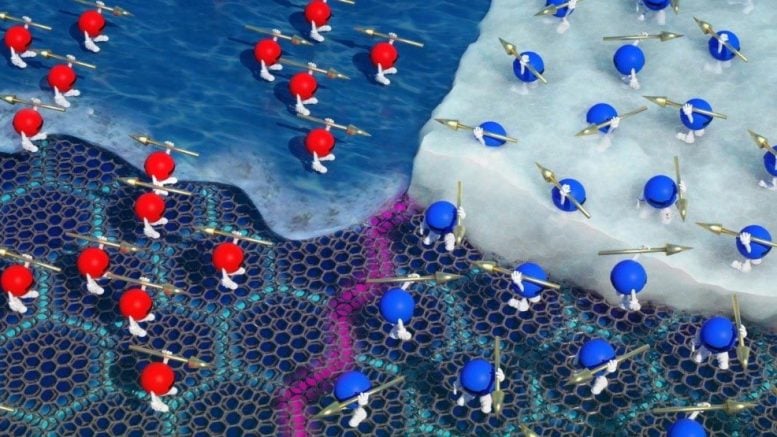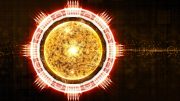
Pomeranchuk effect in magic angle graphene, revealing an exotic transition between two phases: A (Fermi) liquid phase, where the spatial positions of electrons are disordered but their magnetic moments (arrows) are perfectly aligned, and a solid-like phase where the electrons are ordered in space but their magnetic moments are fluctuating freely. Counterintuitively, the liquid phase transforms to the solid-like phase upon heating. Credit: Weizmann Institute of Science
Researchers at the Weizmann Institute of Science and the Massachusetts Institute of Technology discover a surprising phase transition in twisted bilayer graphene.
Most materials go from being solids to liquids when they are heated. One rare counter-example is helium-3, which can solidify upon heating. This counterintuitive and exotic effect, known as the Pomeranchuk effect, may now have found its electronic analog in a material known as magic-angle graphene, says a team of researchers from the Weizmann Institute of Science led by Prof. Shahal Ilani, in collaboration with Prof. Pablo Jarillo-Herrero’s group at the Massachusetts Institute of Technology (MIT).
This result, published today (April 7, 2021) in Nature, comes thanks to the first ever measurement of electronic entropy in an atomically-thin two dimensional material. “Entropy describes the level of disorder in a material and determines which of its phases is stable at different temperatures,” explains Ilani. “Our team set up to measure the electronic entropy in magic angle graphene to resolve some of its outstanding mysteries, but discovered another surprise.”
Giant magnetic entropy
Entropy is a basic physical quantities that is not easy to grasp or measure directly. At low temperatures, most of the degrees of freedom in a conducting material freeze out, and only the electrons contribute to the entropy. In bulk materials, there is an abundance of electrons, and thus it is possible to measure their heat capacity and from that deduce the entropy. In an atomically-thin two-dimensional material, due to the small number of electrons, such a measurement becomes extremely challenging. So far, no experiments succeeded in measuring the entropy in such systems.
To measure the entropy, the Weizmann team used a unique scanning microscope comprising of a carbon nanotube single-electron transistor positioned at the edge of a scanning probe cantilever. This instrument can spatially image the electrostatic potential produced by electrons in a material, with an unprecedented sensitivity. Based on Maxwell’s relations that connect the different thermodynamic properties of a material, one can use these electrostatic measurements to directly probe the entropy of the electrons.
“When we performed the measurements at high magnetic fields, the entropy looked absolutely normal, following the expected behavior of a conventional (Fermi) liquid of electrons, which is the most standard state in which electrons exist at low temperatures. Surprisingly, however, at zero magnetic field, the electrons exhibited giant excess entropy, whose presence was very mysterious.” says Ilani. This giant entropy emerged when the number of electrons in the system was about one per each site of the artificial “superlattice” formed in magic angle graphene.
Artificial “superlattice” in twisted layers of graphene
Graphene is a one-atom-thick crystal of carbon atoms arranged in a hexagonal lattice. When two graphene sheets are placed on top of each other with a small and special, or “magic,” misalignment angle, a periodic moiré pattern appears that acts as an artificial “superlattice” for the electrons in the material. Moiré patterns are a popular effect in fabrics and emerge wherever one mesh overlays another at a slight angle.
In magic-angle graphene, the electrons come in four flavors: spin “up” or spin “down,” and two “valleys.” Each moiré site can thus hold up to four electrons, one of each flavor.
Researchers already knew that this system behaves as a simple insulator when all moiré sites are completely full (four electrons per site). In 2018, however, Prof. Jarillo-Herrero and colleagues discovered to their surprise that it can be insulating at other integer fillings (two or three electrons per moiré site), which could only be explained if a correlated state of electrons is formed. However, near a filling of one electron per moiré site, the vast majority of transport measurements indicated that the system is quite simple, behaving as an ordinary metal. This is exactly where the entropy measurements by the Weizmann-MIT team found the most surprising results.
“In contrast to the behavior seen in transport near a filling of one electron per moiré site, which is quite featureless, our measurements indicated that thermodynamically, the most dramatic phase transition occurs at this filling,” says Dr. Asaf Rozen, a lead author in this work. “We realized that near this filling, upon heating the material, a rather conventional Fermi liquid transforms into a correlated metal with a giant magnetic entropy. This giant entropy (of about 1 Boltzmann constant per lattice site) could only be explained if each moiré site has a degree of freedom that is completely free to fluctuate.”
An electronic analog of the Pomeranchuk effect
“This unusual excess entropy reminded us of an exotic effect that was discovered about 70 years ago in helium-3,” says Weizmann theorist Prof. Erez Berg. “Most materials, when heated up, transform from a solid to a liquid. This is because a liquid always has more entropy than the solid, as the atoms move more erratically in the liquid than in the solid.” In helium-3, however, in a small part of the phase diagram, the material behaves completely oppositely, and the higher temperature phase is the solid. This behavior, predicted by Soviet theoretical physicist Isaak Pomeranchuk in the 1950s, can only be explained by the existence of another “hidden” source of entropy in the system. In the case of helium-3, this entropy comes from the freely rotating nuclear spins. “Each atom has a spin in its nucleus (an ‘arrow’ that can point in any direction),” explains Berg. “In liquid helium-3, due to the Pauli exclusion principle, exactly half of the spins must point up and half must point down, so spins cannot freely rotate. In the solid phase, however, the atoms are localized and never come close to each other, so their nuclear spins can freely rotate.”
“The giant excess entropy that we observed in the correlated state with one electron per moiré site is analogous to the entropy in solid helium-3, but instead of atoms and nuclear spins, in the case of magic angle graphene we have electrons and electronic spins (or valley magnetic moments),” he says.
The magnetic phase diagram
To establish the relation with the Pomeranchuk effect further, the team performed detailed measurements of the phase diagram. This was done by measuring the “compressibility” of the electrons in the system- that is, how hard it is to squeeze additional electrons into a given lattice site (such a measurement was demonstrated in twisted bilayer graphene in the team’s previous work). This measurement revealed two distinct phases separated by a sharp drop in the compressibility: a low-entropy, electronic liquid-like phase, and a high-entropy solid-like phase with free magnetic moments. By following the drop in the compressibility, the researchers mapped the boundary between the two phases as a function of temperature and magnetic field, demonstrating that the phase boundary behaves precisely as expected from the Pomerachuk effect.
“This new result challenges our understanding of magic angle graphene,” says Berg. “We imagined that the phases in this material were simple – either conducting or insulating, and expected that at such low temperatures, all the electronic fluctuations are frozen out. This turns out not to be the case, as the giant magnetic entropy shows.”
“The new findings will provide fresh insights into the physics of strongly correlated electron systems and perhaps even help explain how such fluctuating spins affect superconductivity,” he adds.
The researchers acknowledge that they do not yet know how to explain the Pomeranchuk effect in magic-angle graphene. Is it exactly as in helium-3 in that the electrons in the solid-like phase remain at a great distance from each other, allowing their magnetic moments to stay completely free? “We are not sure,” admits Ilani, “since the phase we have observed has a ‘spit personality’ – some of its properties are associated with itinerant electrons while others can only be explained by thinking of the electrons as being localized on a lattice.”
Reference: “Entropic evidence for a Pomeranchuk effect in magic-angle graphene” by Asaf Rozen, Jeong Min Park, Uri Zondiner, Yuan Cao, Daniel Rodan-Legrain, Takashi Taniguchi, Kenji Watanabe, Yuval Oreg, Ady Stern, Erez Berg, Pablo Jarillo-Herrero and Shahal Ilani, 7 April 2021, Nature.
DOI: 10.1038/s41586-021-03319-3
Prof. Shahal Ilani’s research is supported by the Sagol Weizmann-MIT Bridge Program; the André Deloro Prize for Scientific Research; the Rosa and Emilio Segre Research Award; and the Leona M. and Harry B. Helmsley Charitable Trust.
Prof. Erez Berg’s research is supported by Irving and Cherna Moskowitz.
Prof. Yuval Oreg’s research is supported by the Lady Davis Professorial Chair of Experimental Physics. Prof. Oreg is the Head of the Maurice and Gabriella Goldschleger Center for Nanophysics.
Prof. Ady Stern’s research is supported by the Veronika A. Rabl Physics Discretionary Fund and the Zuckerman STEM Leadership Program.









Be the first to comment on "Surprising Entropy Measurements Reveal Exotic Effect in “Magic-Angle” Graphene"